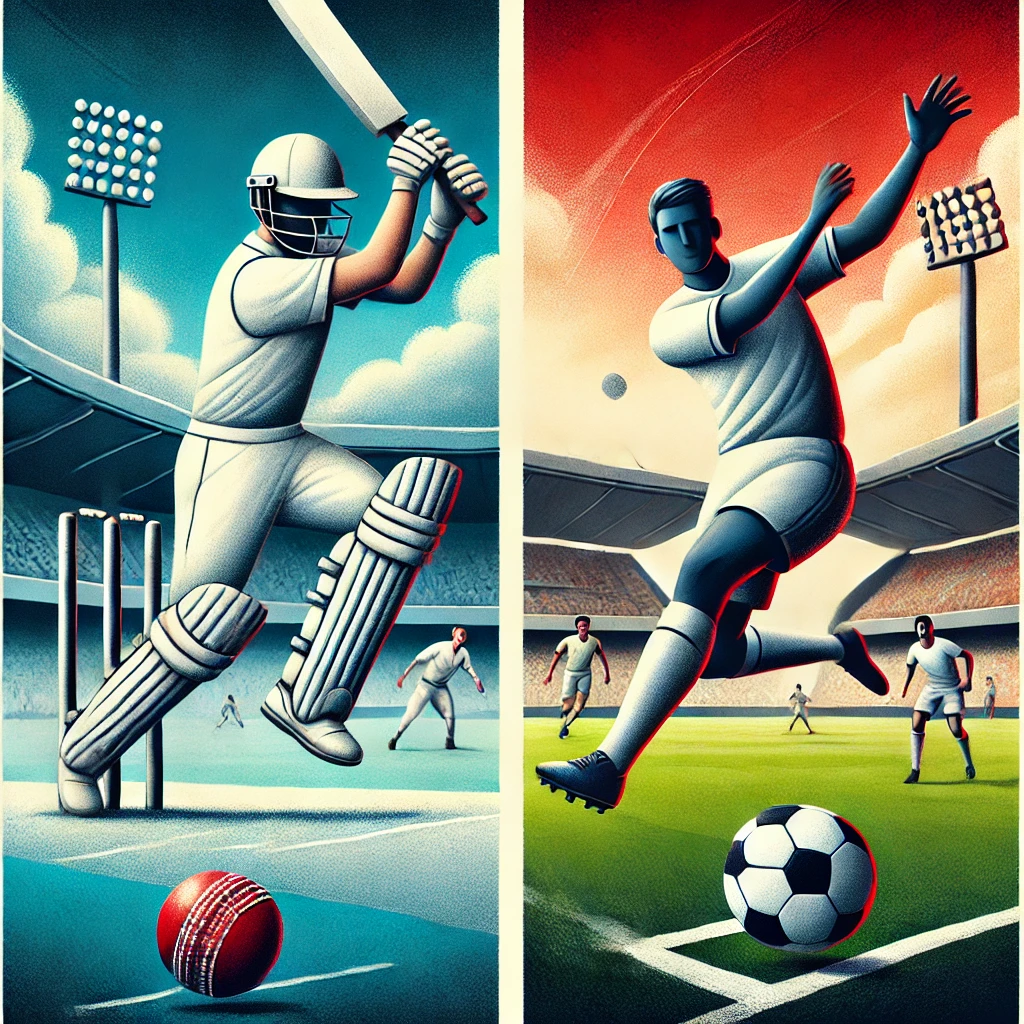When it comes to global sports, cricket and football (soccer) stand out as two of the most popular and widely played games. Each sport has its own unique appeal, history, and fan base. In this article, we’ll delve into the key differences and similarities between cricket and football, comparing various aspects such as origin, gameplay, global popularity, and more. Whether you’re a sports enthusiast or simply curious, this comparison will give you a deeper understanding of these two iconic sports.

1. Origin and History
Cricket: Cricket traces its origins back to England in the 16th century. It began as a children’s game and evolved over centuries into the organized sport we know today. The first recorded cricket match took place in 1646, and the sport gradually spread across the British Empire, becoming especially popular in countries like India, Australia, and the West Indies.
Football: Modern football, or soccer, also originated in England, but much later, in the 19th century. While the basic concept of kicking a ball has ancient roots, it was in the 1800s that the rules were formalized. The formation of The Football Association (FA) in 1863 marked the beginning of organized football, and the sport quickly became the world’s most popular game.
2. Number of Players
Both cricket and football are team sports that require 11 players on each side. However, the roles and positions within the teams differ significantly. In cricket, players are divided into batsmen, bowlers, and fielders, while in football, players take on positions such as forwards, midfielders, defenders, and a goalkeeper.
3. Duration of the Game
Cricket: The duration of a cricket match can vary greatly depending on the format. Test matches can last up to five days, with each day consisting of around six hours of play. One Day Internationals (ODIs) are completed in about eight hours, while Twenty20 (T20) matches are the shortest, typically lasting around three hours.
Football: A standard football match lasts 90 minutes, divided into two halves of 45 minutes each, with a 15-minute halftime break. In knockout tournaments, if the match is tied at the end of regulation time, extra time and a penalty shootout may be used to determine the winner.
4. Scoring System
Cricket: In cricket, runs are the primary method of scoring. Batsmen score runs by hitting the ball and running between the wickets. The team with the most runs at the end of the match wins. The complexity of cricket scoring includes various forms of dismissals, boundary hits (fours and sixes), and extras like wides and no-balls.
Football: Football’s scoring system is simpler: teams score by getting the ball into the opponent’s goal. Each goal counts as one point, and the team with the most goals at the end of the match wins. The low-scoring nature of football makes every goal significant and often leads to intense, edge-of-the-seat moments.
5. Global Popularity
Cricket: Cricket enjoys immense popularity in countries like India, Pakistan, Australia, England, and South Africa. In India, cricket is more than just a sport—it’s a religion. The Cricket World Cup, especially, garners billions of viewers worldwide.
Football: Football is the most popular sport on the planet, with an estimated 4 billion fans. It is particularly dominant in Europe, South America, Africa, and parts of Asia. The FIFA World Cup is the most-watched sporting event globally, attracting billions of viewers.
6. Field Shape and Size
Cricket: Cricket is played on an oval-shaped field with a 22-yard pitch at the center. The size of the ground can vary, but international cricket grounds typically have a diameter between 137 to 150 meters.
Football: Football is played on a rectangular field, generally 100-110 meters long and 64-75 meters wide. The standardization of football field dimensions ensures consistency across different stadiums and competitions.
7. Ball Characteristics
Cricket: The cricket ball is hard and made of cork, covered with leather. It weighs between 156 and 163 grams. The ball’s condition plays a crucial role in the game, influencing swing, seam, and spin.
Football: The football is spherical, made of leather or other synthetic materials, and weighs between 410 and 450 grams. The ball’s size and weight have been standardized to ensure uniformity in play.
8. Game Objective
Cricket: The main objective in cricket is to score more runs than the opposing team. Depending on the format, strategies differ, but the ultimate goal remains the same: outscore the opponent while managing wickets.
Football: In football, the objective is to score more goals than the opposing team within the allotted time. Teams must balance attacking play with defensive solidity to achieve this goal.
9. Playing Equipment
Cricket: Cricket players use a variety of equipment, including bats, pads, helmets, gloves, and other protective gear. The nature of the game, particularly the speed at which the ball can be bowled, necessitates this level of protection.
Football: Football players wear jerseys, shorts, socks, shin guards, and boots. Goalkeepers also wear gloves to help them catch and block shots. The equipment is designed for mobility and protection, particularly for the lower legs.
10. International Competitions
Cricket: Major international cricket tournaments include the Cricket World Cup, ICC T20 World Cup, and The Ashes. These events are highly anticipated and draw millions of viewers.
Football: Football’s major international tournaments include the FIFA World Cup, UEFA Champions League, and Copa América. The FIFA World Cup, held every four years, is the pinnacle of international football.
Conclusion
Cricket and football are two sports that have captured the hearts of millions around the world. Each offers a unique blend of strategy, skill, and excitement. While cricket’s complexity and varied formats appeal to some, football’s simplicity and universal appeal make it the world’s most popular sport. Whether you’re a fan of cricket’s tactical depth or football’s fast-paced action, both sports offer something for everyone